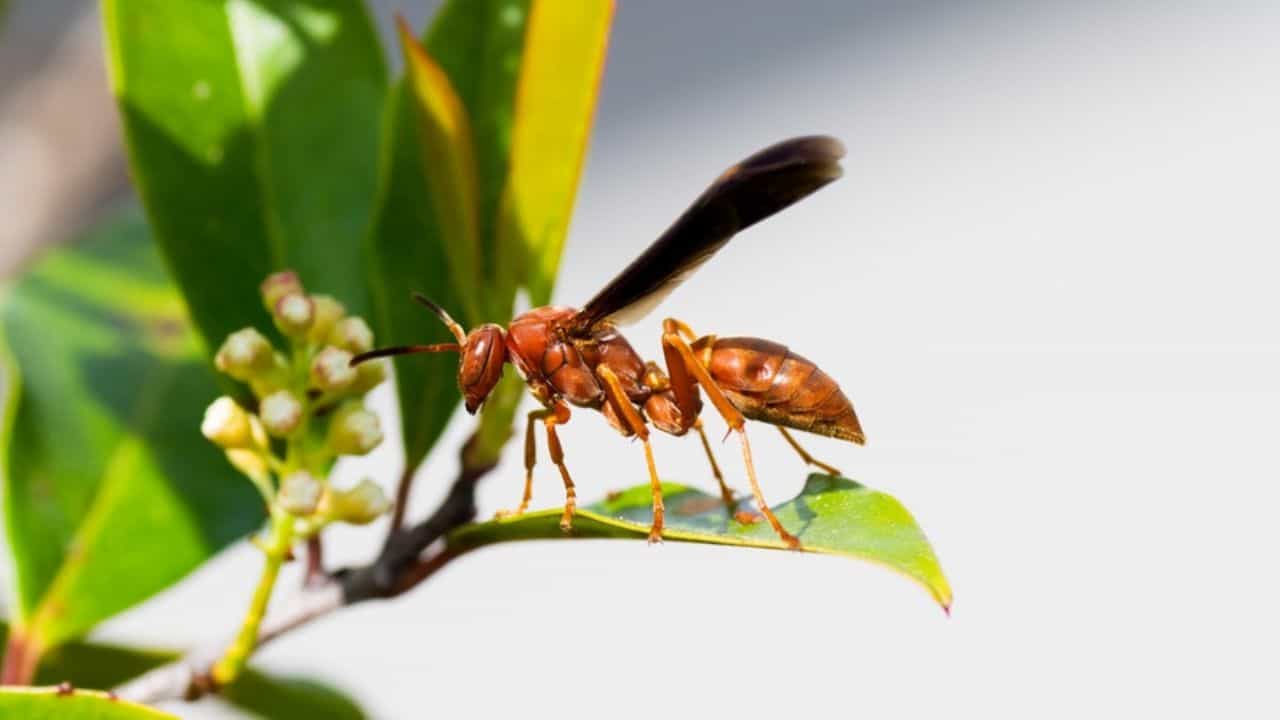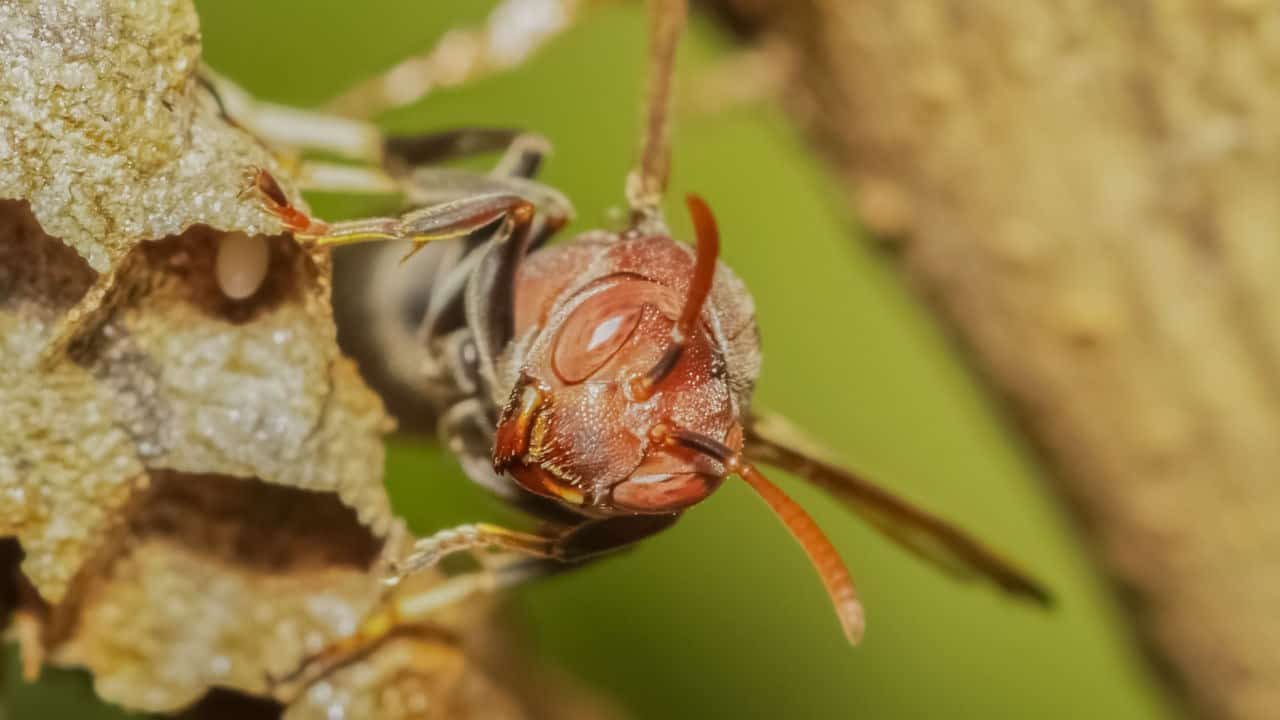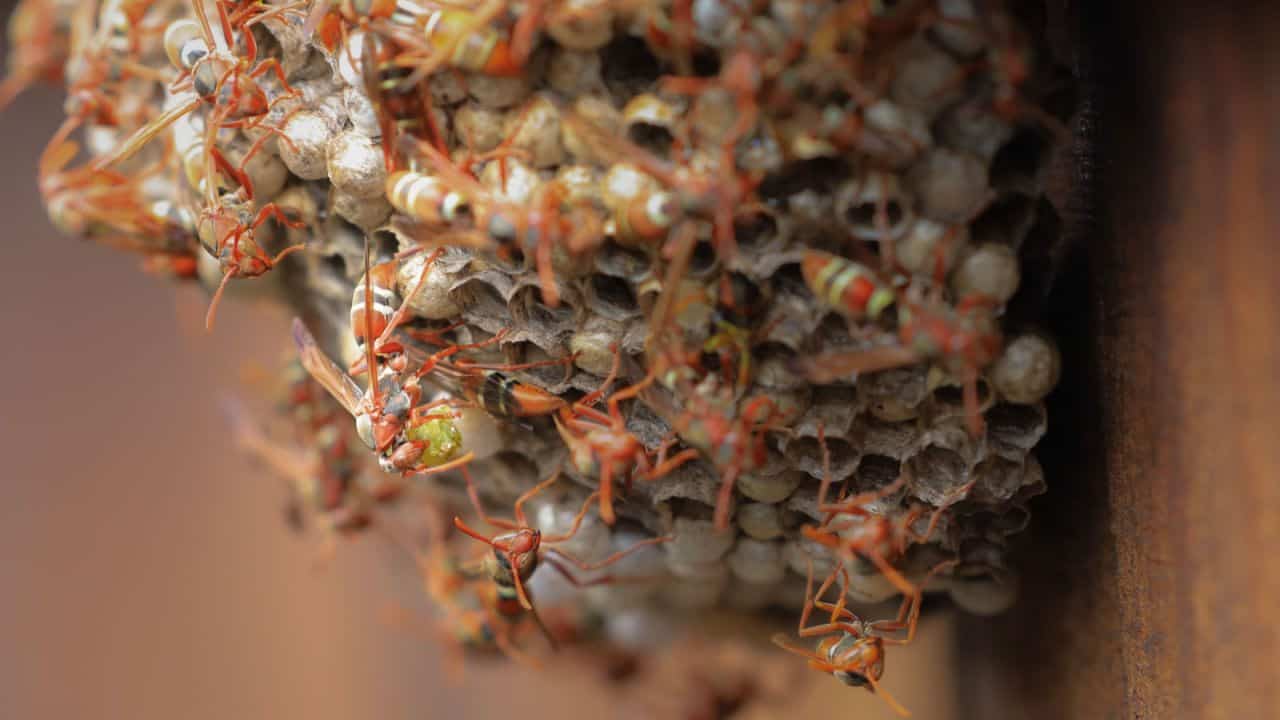Content

Growing up in the eastern United States, I often encountered red wasps, one of two species found in this region. The other is Polistes rubiginosus, but Polistes carolina is more familiar to me.
These social insects belong to the family Vespidae and are characterized by thinner ridges on the propodeum. Red wasps are members of the paper wasp subfamily Polistinae and are known for their unique nests.
Their long, red to reddish-brown bodies combined with dark wings make red wasps easily recognizable. I have seen their nests primarily in the southern US, including areas such as Texas, Florida and as far north as Kansas and Illinois. Red wasps have some of the largest nests among paper wasps, which typically grow to the size of dinner plates.
In my experience, these wasps tend to build their nests near man-made structures, so care must be taken when handling them. Female red wasps sting when provoked or when defending their nests, which can lead to an allergic reaction in some people. So if you see one of their impressive nests nearby, it's best to stay away from it.
If you're a homeowner, there's no denying that pests like red wasps can cause a lot of stress. Not only do they look scary, but they also sting terribly. Therefore, it is natural to want to eliminate them as soon as possible. But before you do, it's important to understand what you're dealing with.
In this article, I'll tell you everything you need to know about red wasps, including how to identify them, prevent them, and control them effectively.

What is a red wasp?
Red wasps are stinging insects native to North America. They are a type of paper wasp, which means they build their nests from wood fibers and saliva, which gives their nests a papery appearance.
They are typically reddish-brown in color with yellow stripes on the abdomen and can grow up to 1.5 inches in length. Like other wasps, they have a narrow waist, two pairs of wings and a stinger.
Red wasps are social insects that live in colonies that can contain up to several hundred individuals. Each colony has a queen who is responsible for laying eggs and creating new colonies. The workers, all female, care for the nest, collect food, and defend the colony.
They obtain food by feeding on the nectar of flowers, but can also feed on live insects. Conversely, red paper wasps have a variety of predators, including spiders, badgers and other arthropods.
As for habit, these wasps build their nests in open areas, including inside eaves, along windows and door frames, outbuildings and under decks.
While at the University of Arkansas Arthropod Museum, I found a special segment of red wasps belonging to the species Polistes carolina. This museum exhibit brought attention to the physical characteristics of these wasps, highlighting their distinct red coloration. He also shared interesting facts about their distribution, which extends from New York to Florida and west to Kansas and Texas.
Life cycle of the red wasp
Red wasps undergo complete metamorphosis, meaning they go through four distinct stages: egg, larva, pupa and adult.
In spring, the queen emerges from hibernation and begins building a nest. She chews wood fibers and mixes them with saliva to create a paper pulp, which she uses to build her nest. The nest starts out small but grows over time as more wasps are born and the colony expands.
The queen lays eggs, which hatch into larvae that feed on other insects that the queen catches. The larvae eventually spin a cocoon, pupate, and become adults. These new adults take over the care of the nest and the next generation of eggs. The lifespan of the red wasp is about a year.
In late summer or early fall, workers begin to die off and reproductive males and females begin to leave their nests to mate. After mating, the males die and the fertilized females find a protected place to overwinter and begin to form colonies the following spring.
Red wasps are important predators, feeding on a variety of insects including caterpillars, flies and spiders. They can also be beneficial to gardeners and farmers by controlling pest populations.
However, their bite can be painful and dangerous for allergy sufferers. If you encounter a red wasp, it is best to give it space and not disturb its nest.

How to recognize red wasps
Red wasps are a common sight in many parts of the United States. These wasps are known for their distinctive coloring and paper-like nests. They are easily recognized by their reddish-brown color, black wings and yellow legs. Queens are slightly larger than workers and can reach an inch in length.
Red wasps are often mistaken for other wasp species, such as yellow wasps, but they have some distinct differences. They are also more aggressive than other wasp species and will fiercely defend their nests.
If you see a nest in or around your home, it is most likely a red wasp nest. These nests are usually found in sheltered areas such as eaves, attics and entryways. They are made from a papery material that wasps create by chewing wood fibers and mixing them with saliva.
Red wasps are beneficial insects that play an important role in controlling other insect populations. They feed on a variety of insects, including caterpillars, flies and other wasps. However, if their nest is disturbed or threatened, they will not hesitate to attack. It is important to be careful around red wasps and not disturb their nests.

Signs of a red wasp infestation
Red wasps are a common problem for homeowners, especially during the summer months.
One of the easiest ways to find out if you have a red wasp infestation is to look for their paper nests. These nests are usually found in protected areas such as eaves, rafters and tree branches. The nests are made from chewed wood and saliva, which creates a papery texture.
They can vary in size, but are usually about the size of a basketball. If you see one of these nests on your property, it is a sure sign that you have a red wasp infestation.
Another sign of a red wasp infestation is the presence of large numbers of wasps flying around the area. If you see more than a few wasps, it is likely that there is a nest nearby. Red wasps are social insects, which means they live in large colonies. If you see a lot of wasps flying, this is a sure sign that there is a nest nearby.
It is important to note that red wasps can be aggressive if they feel threatened. If you see a lot of wasps flying, it's best to stay away from the area.
Not only are red wasps a nuisance, but they can also be dangerous to people who are allergic to their venom. If you or someone in your family has a severe allergy to wasp stings, it is important to take extra precautions to avoid being stung.
This may include staying indoors during periods of peak wasp activity, wearing protective clothing when outdoors, and using an epinephrine auto-injector in case of an emergency.

What damage do red wasps cause?
Red wasps are a common sight in many areas of the world, and although they may seem harmless, they can cause significant damage to both people and property.
bites
One of the most obvious ways red wasps cause damage is through their stings. I know firsthand that a red wasp sting can be quite painful. The first sensation may be a sharp pain or burning sensation at the site of the bite.
When a red wasp stings, it injects venom through the stinger into the target. The venom contains various proteins, enzymes and other chemicals that can cause pain, itching and swelling.
If you disturb a red wasp nest or accidentally step on one of these insects, you may be stung several times. These stings can be quite painful and cause an allergic reaction in some people. In severe cases, a red wasp sting can even be life-threatening.
Common symptoms after a bite may include:
- redness: The area around the bite may become red and swollen.
- Itchy: The affected area may be very itchy for several hours.
- swelling: The venom can cause swelling of the skin around the bite site, sometimes significant.
- hives: In some cases, raised red spots (hives) may appear on the skin.
These symptoms can last from a few hours to several days, depending on the person's reaction and the severity of the bite.
Although most people can tolerate red wasp stings without serious consequences, some people may experience an allergic reaction. This can be dangerous and should not be taken lightly.
Nests
Red wasps build their nests from wood fibers, which means they can damage wood structures in and around your home.
If left unchecked, a red wasp nest can grow quite large and cause significant damage to the surrounding area. Additionally, red wasp nests can attract other pests such as ants and termites, which can further damage your property.
Infections
If you have red wasps on your property, it can quickly become a serious problem. Red wasps reproduce quickly, and a small nest can turn into a large infestation in a matter of weeks.
These insects can be difficult to get rid of, and attempting to destroy the nest yourself can be dangerous. If you suspect you have a red wasp infestation, it is best to call a professional pest control company to take care of the problem.

How to prevent red wasps
Sealing cracks and crevices
One of the best ways to prevent red wasps from taking up residence in your home is to seal all the cracks and crevices around your home. This includes gaps around windows and doors, as well as any cracks or holes in the walls or foundation. Red wasps are small and can easily slip into even the tiniest of holes, so it's important to seal your home thoroughly.
Remove food source
In addition to sealing your home, you should also remove any sources of food and water that may be attracting red wasps. This includes pet food and water dishes, bird feeders, and even standing water in your yard. Red wasps are attracted to sweet and sugary foods, so it's important to keep these items stored away or cleaned up.
Trimming trees and bushes
Another way to keep red wasps from taking up residence in your yard is to trim trees and bushes away from your home. Red wasps like to build their nests in protected places, such as under eaves, trees and bushes. By keeping these areas clean, you will reduce the likelihood that red wasps will decide to build their nests in your yard.
Don't leave food unattended
It's also important to be mindful of eating and drinking outdoors. Red wasps are attracted to the smells of food and drink, so it is important not to leave these items unattended. If you're hosting an outdoor picnic or gathering, be sure to keep all food and drinks covered or stored away when not in use.

Keep trash cans closed
You should also keep trash cans tightly closed to prevent the smell of rotting food from attracting red wasps. Rubbish bins should be emptied regularly and stored away from the home to minimize the risk of red wasps setting up shop nearby.
How to Get Rid of Red Wasps
If you have a red wasp infestation, it can be a serious nuisance and even a health hazard. Red wasps are known for their aggressive behavior and painful stings, which can cause allergic reactions in some people.
Luckily, there are several methods you can use to control them and prevent them from taking over your home or yard.
Insekticidы
If you prefer to deal with the infestation yourself, there are several methods you can use. Insecticide sprays are a common and effective way to kill red wasps. These sprays can be purchased at most hardware or home improvement stores.
When using these sprays, it is important to follow the instructions carefully and wear protective equipment as they may be toxic if swallowed or inhaled.
Traps
Another method of dealing with red wasps is the use of traps. There are several types of traps available, including sticky traps and pheromone traps. These traps work by attracting wasps and keeping them trapped, preventing them from breeding and spreading the infestation.
However, it is important to place traps in the correct location and dispose of them correctly to prevent other animals from getting caught in them.
Baits
Baits are another option for controlling red wasps. These baits contain a toxic substance that the wasps ingest and then take back to their nests, killing the entire colony.
Baits can be effective, but they can also be dangerous if used incorrectly. It is important to follow the instructions carefully and keep baits out of the reach of children and pets.
Professional extermination
The most effective method of dealing with a red wasp infestation is to call a professional pest control company. These professionals have the knowledge and equipment to eliminate infestations safely and effectively.
They can also give you tips on preventing future infestations and keeping your home and yard pest-free. This is especially important if you find a nest of red wasps on your property and you are allergic to them.
Dealing with a red wasp infestation requires patience, persistence, and the right tools and knowledge. Whether you decide to call a professional pest control company or handle it yourself, it is important to take action as soon as possible to prevent the infestation from getting worse.
With the right approach, you can eliminate red wasps and enjoy a pest-free home and yard.
Other Wasp guides from BezTarakanov:
The most common types of wasps (and how to identify them)
How to effectively get rid of wasps and prevent new nests from appearing
Previous